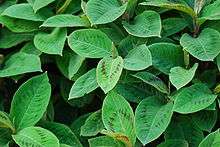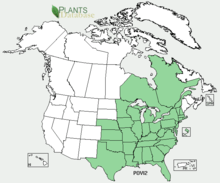Persicaria virginiana
Persicaria virginiana, also called jumpseed,[2] Virginia knotweed or woodland knotweed[3] is a North American species of smartweed within the buckwheat family. It is unusual as a shade-tolerant member of a mostly sun-loving genus. Jumpseed is a perennial, named for its seeds which can "jump" several feet when a ripe seedpod is disturbed.
| Persicaria virginiana | |
|---|---|
 | |
| Scientific classification | |
| Kingdom: | Plantae |
| Clade: | Tracheophytes |
| Clade: | Angiosperms |
| Clade: | Eudicots |
| Order: | Caryophyllales |
| Family: | Polygonaceae |
| Genus: | Persicaria |
| Species: | P. virginiana |
| Binomial name | |
| Persicaria virginiana | |
 | |
| Range within North America | |
| Synonyms[1] | |
| |
Persicaria virginiana blooms in midsummer to late summer/early fall. It has a stalk of small white flowers.[4]
Description
Like other Persicaria, jumpseed has alternate leaves, with fine-hairy stipular sheaths (ocrea) with bristle-fringed edges which often turn brownish. Flowers, widely spaced along slender stalks, are white to greenish-white, rarely pink-tinged, and fruiting flowers have 2 downward-pointing hook-tipped styles.[3] Persicaria virginiana is easily distinguished from most other Persicaria species by its much larger, more oval-shaped leaves, although a few species also have large leaves. It sometimes has a chevron-shaped marking on the leaves; often a single plant will have this marking on some leaves but not others.
Cultivars and naturalized populations from cultivation show much greater variation than wild-type plants, sometimes having variegation or have more involved red patterning, and sometimes having red or pink flowers.
Distribution and habitat
Persicaria virginiana has a wide native range throughout most of Eastern North America, from Ontario and Quebec, south to Florida, and west as far as Texas, Nebraska, and Minnesota.[2][5]
It naturally occurs in full to partial shade, on riverbanks, woods, cliffs, and rocks.[6]
Cultivation
Many variegated cultivars exist. The plant prefers medium to moist soil and full sun to part shade.[7]
References
- "Persicaria virginiana (L.) Gaertn.", Tropicos, Missouri Botanical Garden
- "Persicaria virginiana", Natural Resources Conservation Service PLANTS Database. USDA, retrieved 12 October 2015
- David M., Brandenburg (2010), National Wildlife Federation Field Guide to Wildflowers of North America, New York: Sterling Publishing, p. 432, ISBN 978-1402741548
- Hinds, Harold R.; Freeman, Craig C. (2005), "Persicaria virginiana", in Flora of North America Editorial Committee (ed.), Flora of North America North of Mexico (FNA), 5, New York and Oxford – via eFloras.org, Missouri Botanical Garden, St. Louis, MO & Harvard University Herbaria, Cambridge, MA
- "Persicaria virginiana", County-level distribution map from the North American Plant Atlas (NAPA), Biota of North America Program (BONAP), 2014
- "Persicaria virginiana", Plants of Wisconsin, University of Wisconsin–Stevens Point, Robert W. Freckmann Herbarium, archived from the original on 2013-05-30
- "Persicaria virginiana (Variegata Group)", Plant Finder, Missouri Botanical Garden
| Wikimedia Commons has media related to Persicaria virginiana. |
